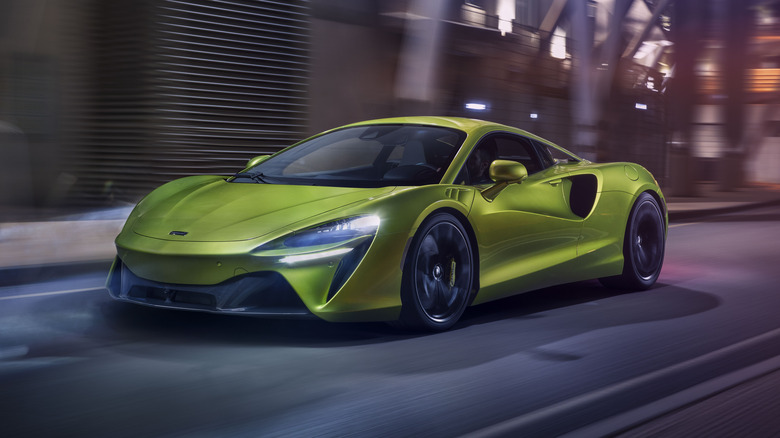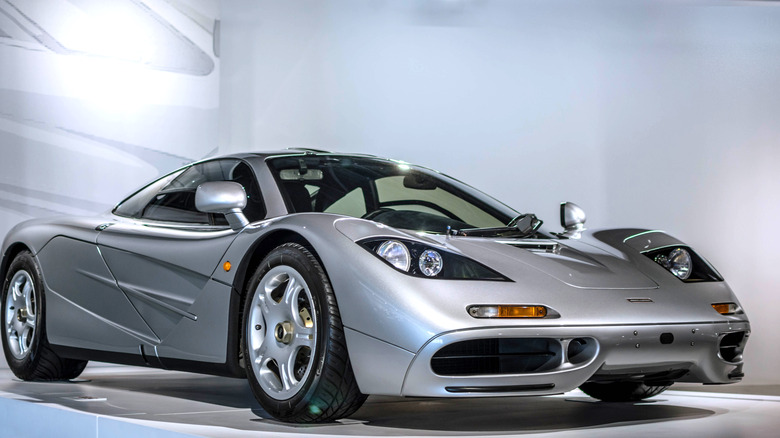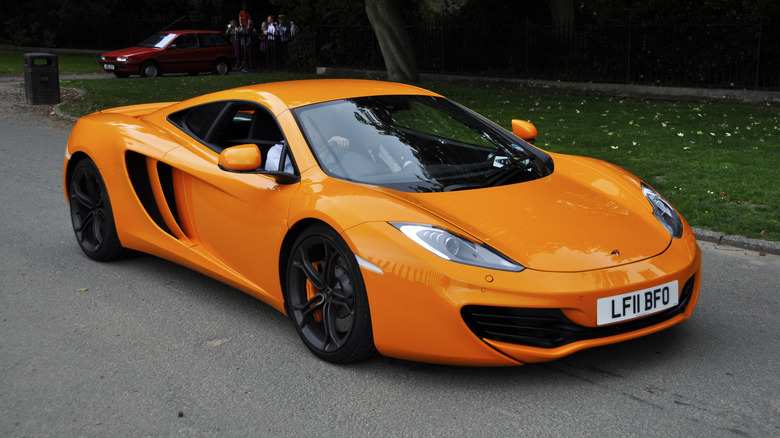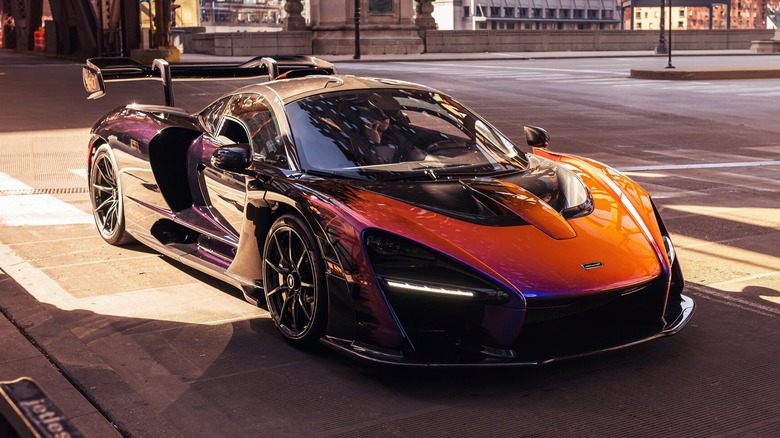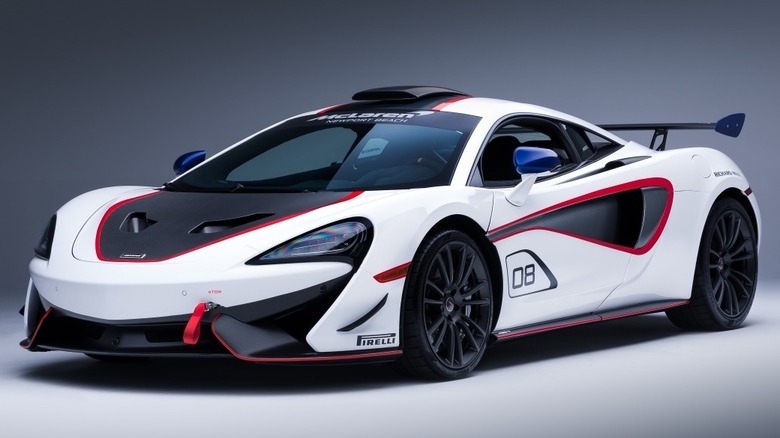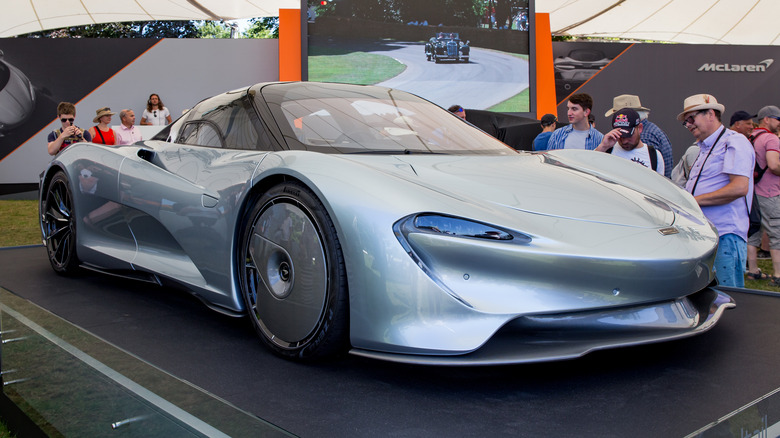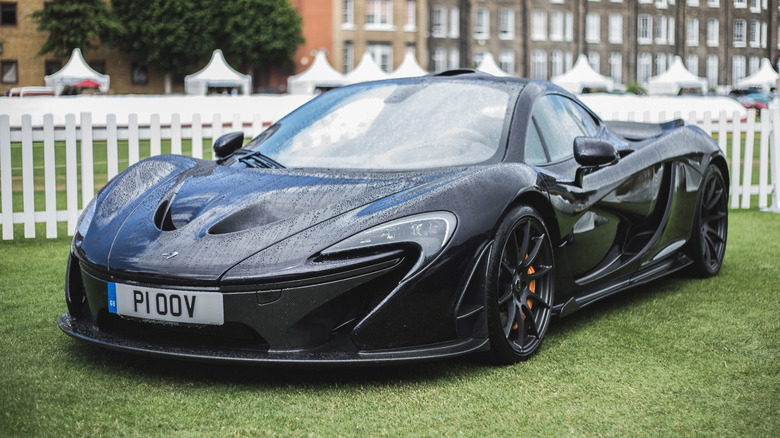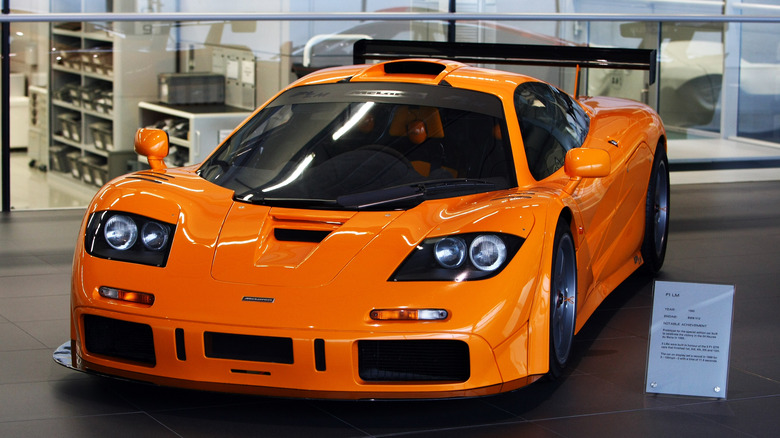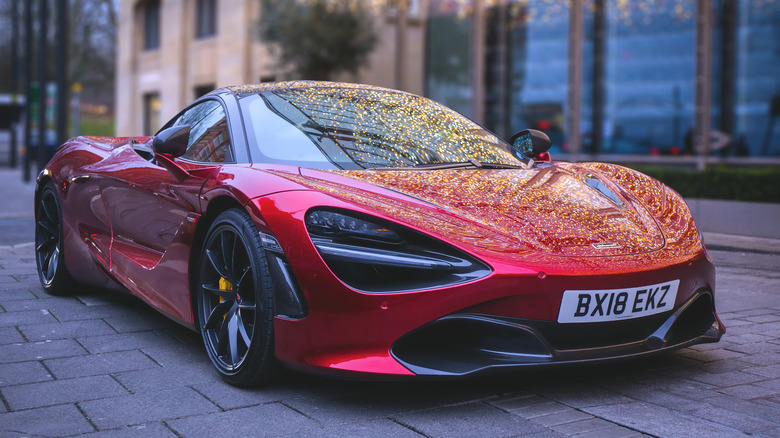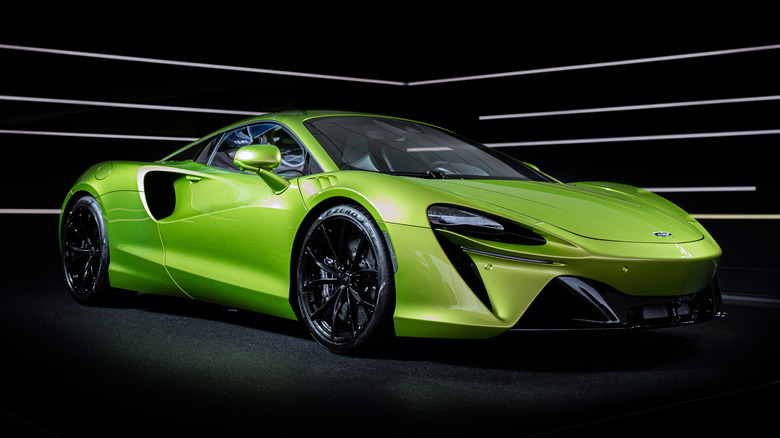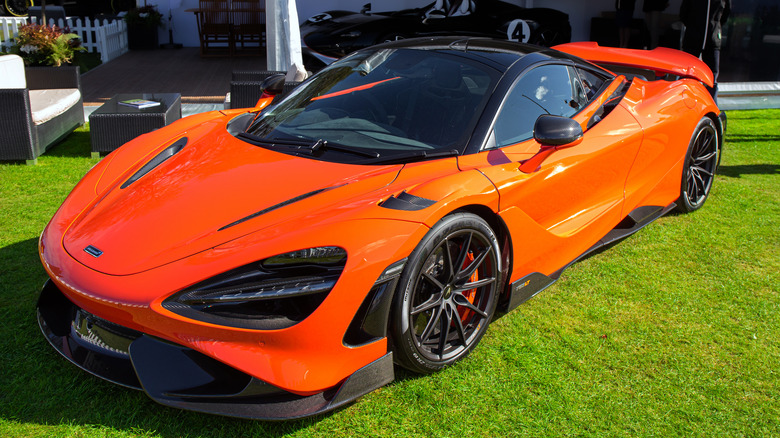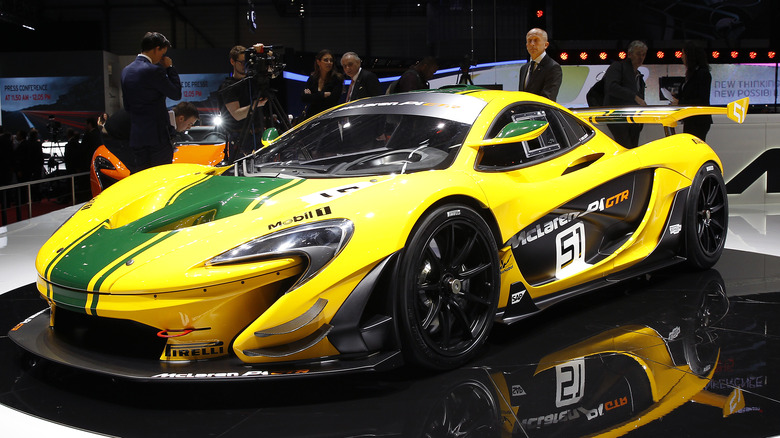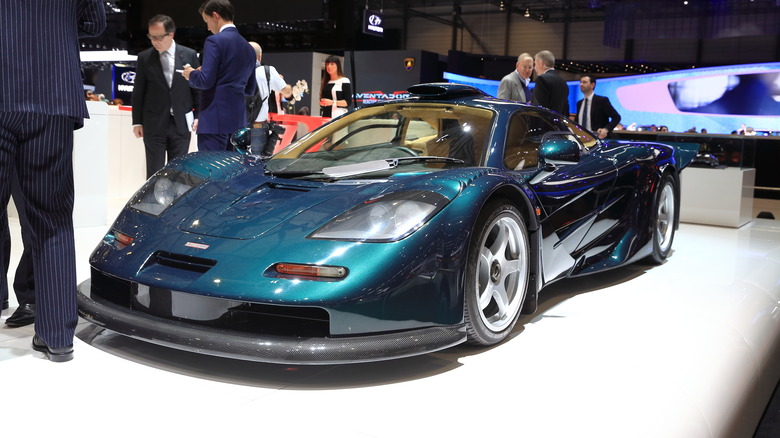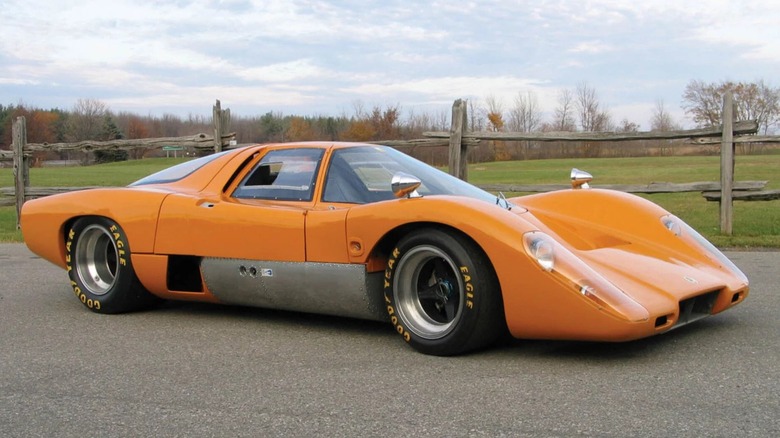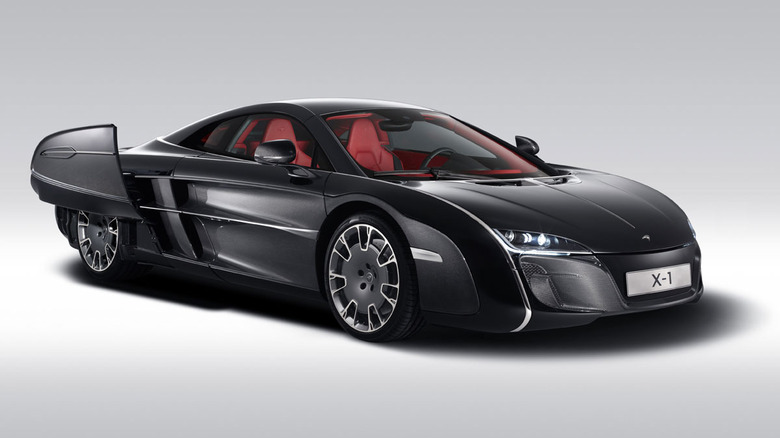15 Best McLarens Of All Time
New Zealand-born racing driver Bruce McLaren founded his eponymous company in 1963, having arrived in the U.K. just a few years earlier (via McLaren). A year later, he'd built his first race car, the M1A, which quickly proved itself to be highly competitive in racing series both in Europe and in America. By 1965, McLaren had decided to enter Formula 1, and by 1968, had found himself at the top step of the podium at the Belgian Grand Prix. Throughout the following decades, the automaker would continue to race in Formula 1, remaining a dominant force and breaking records during an exceptionally successful season in 1988.
It was shortly after this that McLaren decided to make a road car, and the resulting F1 proved to be just as dominant on the road as the company's race cars were on the track. After a period of inactivity from McLaren's road car division throughout the early 2000s, the brand returned with the ill-fated Mercedes-Benz SLR McLaren, the development of which was hampered by disagreements between the two manufacturers. Following this, McLaren decided to launch its road car division as a standalone brand again, unveiling the MP4-12C in 2011. Since then, the company has launched a slew of excellent driver's cars, each one managing to push the boundaries of road-legal performance further than before.
McLaren F1
To any enthusiast worth their salt, the McLaren F1 needs no further introduction. Even McLaren itself calls it "the greatest supercar ever built," and auction prices reflect that sentiment. Data from Glenmarch shows a steady trend upwards in selling prices over the past 10 years, with the most recent publicly-auctioned F1 selling for just over $20 million at Gooding & Co's 2021 Pebble Beach auction. The F1 was arguably the first ever hypercar, redefining the boundaries of what a performance car could do when it debuted in 1992 (via Auto Express).
Its BMW-sourced 6.1L V12 engine produced 618 horsepower and propelled the McLaren to a record-breaking top speed of 243 mph in 1998, a feat that would remain unchallenged until the Bugatti Veyron came along in 2005, Auto Express notes. To achieve such a groundbreaking speed, the F1 utilized the most cutting-edge engineering innovations, including engine bay insulation made of gold, and a full carbon-fiber monocoque chassis. Suffice to say, this was the car that transformed the company from being a race car manufacturer to being at the forefront of road car development, and it set the precedent for every McLaren-badged car that followed.
McLaren MP4-12C
The MP4-12C was the first production car from the freshly-revived McLaren Automotive division after its years of dormancy, and it proved that the brand had lost none of its shine during its years away. Some reviewers claimed the car was a performance-by-numbers kind of supercar, lacking the soul of its Italian rivals, but then there were plenty of reviewers (and evidently, owners) who strongly disagreed (via Jalopnik). The most impressive part of the MP4-12C's character was how quickly it could swap between personalities. In the same afternoon, it could be blasting around a race track, commuting back to the city in heavy traffic, and then be parked up at a swanky bar while its owner enjoyed a cocktail.
It was equally adept at handling all of those situations, something which many supercars at the time struggled to do. Tellingly, this versatility has become commonplace in most modern supercars, with accessibility often as much of a selling point as pure performance, and it's arguable that the success of the MP4-12C might have contributed to that change in industry attitudes. Pioneering nature aside, the MP4-12C was a solid first attempt at making a mainstream supercar from a brand that had very little previous experience in the matter, and its success helped build McLaren into the company it is today.
McLaren Senna
Naming a car after one of the greatest Formula 1 drivers of all time is a gamble, but McLaren put apprehensive minds to rest when it unveiled the Senna in 2017. The brand billed its creation as "the ultimate road-legal track car." This was, in other words, the most brutal track day toy that McLaren could feasibly convince regulators to fit with a license plate. It packed a 4.0L twin-turbocharged V8 engine that produced 789 horsepower and 590 lb-ft of torque, yet it only weighed 2,641 lbs.
It was also very much "function over form" in the styling department, to the point where the Senna was called ugly by some. Even McLaren acknowledged, according to Car Throttle, that it wasn't the best-looking car, but promised that actually driving it would alleviate any concerns that buyers might have. It turns out, the brand was right, as the Senna received universal praise for its handling by many reviewers lucky enough to get behind the wheel, including Top Gear. A total of 500 cars were produced at a price of £750,000 each (roughly $966,000), and all were sold before the car was even revealed. Today, it's tricky to find a Senna for less than $1.2 million.
MSO X
If a "regular" McLaren seems a little too common, then the company also has an in-house skunkworks that goes by the name MSO, or Mclaren Special Operations. As well as making one-offs and custom commissions, MSO has also made a limited run of its own car, based off of the 570S. Christened the MSO X, the car raided the 570S GT4 race car's parts bin and stripped out as much of the standard 570's interior as MSO could get away with and still keep the car road legal. The biggest exterior changes (apart from the customizable paint schemes) were the addition of a large fixed rear wing, and a roof-mounted air intake.
The rear wing generated an extra 100 kg (220 lbs) of downforce, and worked in tandem with the revised side skirts to keep the car's Pirelli Corsa tires glued firmly to the asphalt. Inside, the car was equally race-focused, with exposed carbon fiber fittings and minimal luxuries in a bid to shave off every last ounce of weight. Only 10 examples were produced, and all were sold through McLaren Newport Beach in California. Unfortunately for wanna-be owners, every unit was sold before the car was even unveiled in 2018.
McLaren Speedtail
With a 250 mph top speed and a distinctive longtail design, the Speedtail is unlike anything else in McLaren's lineup. It features the same 4.0L V8 engine that's found in the 765LT, but it's also equipped with a Formula E-derived electric motor. The two combined motors are capable of pushing out 1,055 horsepower and 848 lb-ft of torque, enough for a 0-186 mph time of just 13 seconds. To take full advantage of this power, McLaren had to develop a state-of-the-art cooling system which permanently submerged the battery cells in insulative oil to rapidly decrease the internal temperatures of the battery. This allows the Speedtail to deliver peak power outputs over and over without the risk of overheating.
A car as cutting-edge as this was bound to come with an eye-watering price tag, and suffice to say, even the average supercar owner will be very much priced out of Speedtail ownership. Prices started at $2.3 million excluding optional extras and taxes, and only 106 units have been produced.
McLaren P1
The McLaren P1 formed part of the "Holy Trinity" of hypercars when it was released, its surgically-precise handling and focus on pure driver enjoyment setting it apart from its rivals from Porsche and Ferrari. It featured a hybrid powertrain with 903 horsepower on tap, yet all that power was sent to the rear wheels only through a seven-speed twin-clutch automatic transmission (via Top Gear). As well as just being face-meltingly fast, the P1 was also designed to be user friendly at lower speeds, with McLaren taking great care to ensure it could be driven to and from the track just as easily as it could be thrashed at full pelt around said track.
As the spiritual successor to the F1, the P1 had huge shoes to fill, but it delivered on all fronts, and even with a starting price of £866,000 (roughly $1.35 million at the time), all units of the car quickly sold out.
McLaren F1 LM
To celebrate the company's Le Mans win in 1995, McLaren decided to build just five LM cars, which were essentially race cars made just about road legal (via Road and Track). Three of those were snapped up by the Sultan of Brunei, with the remaining two eventually ending up in the U.S. One of those now sits in fashion magnate Ralph Lauren's collection, alongside other gems including a Bugatti Type 57 Atlantic and a Ferrari 250 GTO. A sixth prototype car was also built and retained by McLaren.
The LM boasted an upgraded engine over the standard F1, which boosted power to 680 horsepower, according to Road and Track. A high-downforce kit was also added with a large fixed rear wing, making the LM even more grippy than the regular car. While only five official customer LMs were made, a number of F1 owners have had their cars "upgraded" to LM spec over the years.
McLaren 720S
Longevity is a tricky thing to achieve in the world of performance cars. Few manufacturers have succeeded in creating cars that don't need tweaking over long production runs –- the Pagani Zonda and Nissan GTR are two of the only recent performance cars that come to mind. The McLaren 720S might not quite boast the same multi-decade production run as those cars, but it's still a veteran: it remained unchanged from its initial unveiling in 2017 until it was retired in 2022.
Arguably, there was simply no need for it to change, as the 720S epitomized everything that's great about McLaren's gas-powered supercars. With a twin-turbo 4.0L V8 engine mated to a seven-speed dual clutch transmission, the car was brutally fast at full pelt, yet our reviewer found that it remained reassuringly predictable on the road. The steering was excellently balanced, and the cabin was comfortable enough that doing a daily commute in the car wouldn't be out of the question. The 720S was retired in preparation for the impending switch to electrification, but it remains an excellent benchmark for the next generation of McLaren cars.
McLaren Artura
The Artura might not be the first hybrid McLaren, but it's the first series production hybrid from the brand, and marks the beginning of a new era. It's powered by a 3.0L twin-turbo V6, down two cylinders from McLaren's previous engines, but it still packs 577 horsepower and 431 lb-ft of torque. Add in the e-motor and total power adds up to 671 horsepower and 531 lb-ft of torque. We drove the car earlier in 2022 and found that it felt more cohesive than many other supercars, being easily accessible to less talented drivers yet sharp enough that pros can really wring the best out of it.
The car is just as suited to tearing up the track as it is doing the grocery run, something that can't be said about most other McLarens. We feared it might even be too accessible, as part of the appeal of the brand's cars is that they've previously required some sacrifices to drive. However, the Artura is designed to replace the entry-level Super Series line, and as an accessible way into McLaren ownership, it ticks all the right boxes.
McLaren 765LT
If anyone thought the 720S was a little too tame, McLaren also offered a more extreme longtail version of the car called the 765LT. It packed a 755-horsepower V8 engine and could make the leap from 0-60 mph in just 2.7 seconds, and 0-124 mph in just seven seconds flat. The seven-speed automatic transmission was carried over from the 720S, as was much of the interior, but various weight-saving measures meant that the car weighed 136 pounds less than a "regular" 720S.
McLaren only made 765 examples of the car, and all of those units were quickly accounted for. With a starting price of $358,000, the 765LT was already one of the most expensive cars in the Super Series lineup. The most discerning (and deep-pocketed) buyers could pay an even higher premium to customize the car further through McLaren's Special Operations (MSO) program, with almost every detail able to be tailored to a buyer's exact tastes. The 765LT represented the most uncompromising yet exclusive interpretation of McLaren's series-production cars, and with its race-ready forged alloy wheels and carbon-fiber aero kit, it looked every bit as wild as it drove.
McLaren P1 GTR
Taking its name from the Le Mans-winning McLaren F1 GTR, the P1 GTR was the ultra-exclusive track-bred version of the brand's P1 hypercar. Power was boosted to 986 horsepower, an F1-derived DRS system was installed, and various tweaks were made to reduce the car's drag coefficient even further than the road-going version (via JamesEdition). The GTR was intended to be track-only, but that didn't stop a few determined owners converting their cars to be road-legal anyway (via Evo).
The GTR cost twice the price of a standard P1 –- approximately £1.98 million (a little over $3 million at the time). Converting the car back to road-legal spec cost even more, but the result is one of the most jaw-dropping cars to ever wear a license plate. The revised aero kit and huge rear wing make the car stand out even in a crowd of other hypercars, and its razor-sharp agility makes it feel almost illegal to drive on public highways, reports Evo. The term "race car for the road" could not be summed up more literally.
Mercedes-Benz SLR McLaren Stirling Moss
The original iteration of the Mercrdes-Benz SLR McLaren was a unique and impressive supercar, but it stopped short of being the world-beating performance titan that many had expected it to be (via Autocar). It did, however, spawn several special editions, the most memorable of those being the Stirling Moss speedster. Based on the underpinnings of the SLR 722 Edition, the Stirling Moss stripped away the windshield, windows, and roof, to create a design that drew inspiration from the iconic Type W196S 300 SLR race car of the '50s (via Supercar Nostalgia).
As a result of this slimmed-down design, the Stirling Moss weighed around 170 kg (375 lbs) less than a standard SLR coupe, and it was faster, too, with a top speed of 217 mph and a 0-60 mph time of 3.5 seconds according to Supercar Nostalgia. Production was strictly limited to 75 units and commenced in June 2009, shortly after production of the standard SLR variants had ended. The Stirling Moss marked the end of the rocky partnership between McLaren and Mercedes-Benz, as a few months after production of the car finished, the British brand would go on to launch its own road car division, McLaren Automotive.
McLaren F1 GT
One of the rarest F1 variants of all is the GT, of which just three examples were made. One reportedly resides in Switzerland, while another was purchased by a Japanese collector (via Autoevolution). The third and final car was bought by the Sultan of Brunei, and it was recently spotted being taken to McLaren's HQ for restoration after years out of the public eye (via The Drive).
The GT is sometimes referred to as a "Longtail" due to its stretched rear bodywork, and it was originally designed as a homologation requirement to allow McLaren to compete at the 1997 24 Hours of Le Mans. As well as its distinctive bodywork, Autoevolution reports that the GT uses a modified version of the F1's BMW-sourced engine that's almost identical to the engine used in the GT1 race car. None of the three GTs have ever gone up for sale, although a road-legal version of the GTR race car was offered for sale in 2020 for an undisclosed sum.
McLaren M6GT
McLaren calls the M6GT the "genesis for all McLaren road cars," as it was the first of Bruce McLaren's creations to ever receive a license plate. His goal was to build the fastest road car in the world, although only one prototype of the M6GT ended up being built. McLaren says that its eponymous founder used his prototype to commute to work everyday and attend race meetings, yet it featured plenty of odd quirks, like manually operated lights which had to be raised using finger holes in the pods.
The plan was that McLaren would build a limited run of 250 production cars, and shortly before his death, he struck a deal with Elva Cars to begin constructing them. However, after McLaren passed, the deal was abandoned, and it would take until 1992 before Gordon Murray designed the F1 and the first production McLaren car hit the road.
McLaren X-1
Although it might look wildly different than anything else in McLaren's stable, the one-off X-1 is actually based on an MP4-12C (via Car Magazine). Built at the behest of a notable McLaren collector, the car reportedly took two and a half years to develop and test, with then-chief McLaren test driver Chris Goodwin tasked with honing the car's handling profile to be even sharper than a standard MP4-12C. The body is entirely made of exposed carbon fiber, with no exterior parts carried over from any other production car.
The car debuted at The Quail gathering in California in 2012, then promptly disappeared from public view. It was briefly spotted at the Bahrain GP a year later in 2013 wearing a local license plate, but since then, it's not been seen on the road or at events. It's probably still sitting in a climate-controlled garage somewhere in the Middle East, and it's very unlikely that enthusiasts will catch a glimpse of it again.
